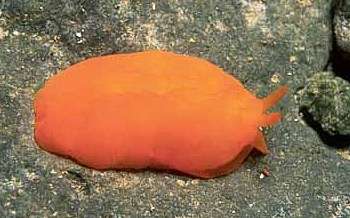
Berthellina edwardsii
(Vayssiere, 1896)
Order: NOTASPIDEA
Superfamily: PLEUROBRANCHOIDEA
Family: Pleurobranchidae
PHOTO
Gran Canaria Island, Spain, Size about 5 cm, depth 0,5 m. PHOTO: Basilio Guerles.
See message below.
References:
• Vayssiere, A. (1896). Description des coquilles de quelques especes nouvelles ou peu connues de pleurochides. Journal de Conchyliologie, 44: 113-137
• Gosliner, T.M. (1988). A review of the genus Berthella (Opisthobranchia: Notaspidea) from the Pacific Coast of North America. The Veliger, 31(1/2): 46-67
Rudman, W.B., 2000 (April 6) Berthellina edwardsii (Vayssiere, 1896). [In] Sea Slug Forum. Australian Museum, Sydney. Available from http://www.seaslugforum.net/find/bertedwa
Related messages
Berthella or Berthellina? from Spain
March 11, 2004
From: Juan Luis Menéndez
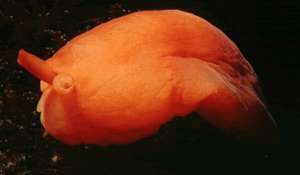
Dear Bill:
This photo was taken last summer in the northern coast of Spain, in Asturias. I think that this is Berthella aurantiaca, but it could be Berthellina edwardsii also. I'm not sure. What do you think?
Thanks
Juan Luis Menéndez
jluism@correo.uniovi.es
Menéndez, J.L., 2004 (Mar 11) Berthella or Berthellina? from Spain. [Message in] Sea Slug Forum. Australian Museum, Sydney. Available from http://www.seaslugforum.net/find/12378Dear Juan,
As you'll see from other messages on this page it is not possible to identify these red, orange or yellow species from one another just from external features. If the internal shell can be felt we can separate species of Berthellina [with a very small shell] from Berthella [with large shell] but it seems there could be more than one species of orange Berthellina in the NE Atlantic, which means we would need to cut it open and study its anatomy before we could be sure.
So at the moment I am putting all these 'orphans' on the Berthellina edwardsii page, but there is no way of knowing if I'm right or wrong.
Best wishes
Bill Rudman
Berthellina? from Cape Verde Islands
August 22, 2003
From: Gérard Breton

Dear Bill,
Here is another message from my dive trip between 22 - 30 March 2003 to two islands of the Cape Verde archipelago: Sal and Fogo.
This one is from Sal, Fereno, rocky bottom, under a stone, - 15m. I understand that what we called Berthella aurantiaca in the Mediterranean sea, should now better be called Berthellina edwardsii. Is it also the case for "my" seaslug from Cape Verde?
Best wishes.
Gérard Breton
Gerard.Breton@ville-lehavre.fr
Breton, G., 2003 (Aug 22) Berthellina? from Cape Verde Islands. [Message in] Sea Slug Forum. Australian Museum, Sydney. Available from http://www.seaslugforum.net/find/10750Dear Gérard,
If you look at earlier messages on this Berthellina edwardsii Page, you will see that the problem is the apparent impossibility of identifying these orange-yellow species externally [see the following message for example]. Bertella aurantiaca and Berthellina edwardsii are both good species, and it seems there may be other similarly coloured species of Berthellina as well which can only be identified by looking at thie internal anatomy.
So although, for convenience, I am putting your message on the Berthellina edwardsii Page, no-one can say what it really is just from a photo
Best wishes,
Bill Rudman
Re: Berthellina edwardsii : confirmation from Cerbere
August 12, 2003
From: Juan Lucas Cervera
Dear Marina,
Did you dissect the specimens or the shell was undetectable externally only? To be sure, it's necessary to dissect the animals.
Lucas.
lucas.cervera@uca.es
Cervera, J.L., 2003 (Aug 12) Re: Berthellina edwardsii : confirmation from Cerbere. [Message in] Sea Slug Forum. Australian Museum, Sydney. Available from http://www.seaslugforum.net/find/10720Berthellina edwardsii : confirmation from Cerbere
August 10, 2003
From: Marina Poddubetskaia
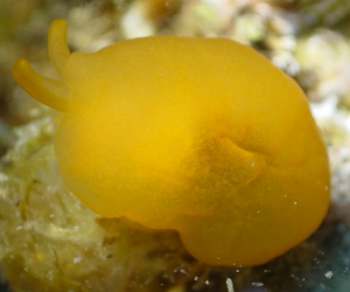
Dear Bill and Lucas,
Last year there was a discussion on the Forum to know if the animals from Cerbere are Berthella aurantiaca or Berthellina edwardsii. This year I saw 3 animals like this in Cerbere and all of them had undetectable shell. So, you were absolutely right ! These guys are Berthellina edwardsii.
Date: July 08, 2003
Location: Cerbere, France, Mediterranean coast
Site: Les 3 moines
Depth: 16m
Size: 20mm
Photos: Marina Poddubetskaia - Nembro website
Cheers,
Marina.
nembro@nembro.info
Poddubetskaia, M., 2003 (Aug 10) Berthellina edwardsii : confirmation from Cerbere. [Message in] Sea Slug Forum. Australian Museum, Sydney. Available from http://www.seaslugforum.net/find/10522Dear Marina,
I think the point we were making is that it's not possible to identify these orange, yellow or whitish animals by colour alone. It's possible that species of Berthella and Berthellina, with this colour range, both occur at Cerbere. So even though its nice to be told I am right, it's possible that last years' animal was Berthella and this years' was a Berthellina. It is indeed a pity they donb't all have distinctive colour patterns like Berthella ocellata.
Best wishes,
Bill Rudman
Berthella or Berthellina from Turkey
July 31, 2003
From: Ferda Buyukbaykal
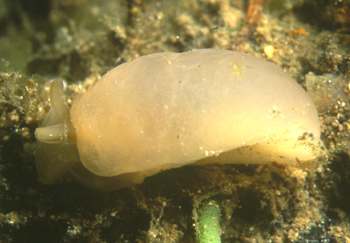
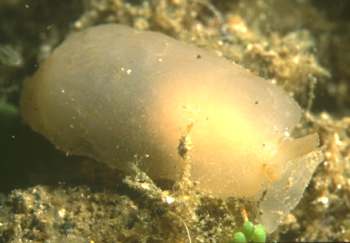
Hello Bill,
I took a new nudibranch in Ayvalik recently. [July 2003 - Aegean Sea coast, Turkey]. It was 5-8 metres deep, sandy/stone bottom and size 3-4 cm.
I think it may be Berthella aurantiaca or Berthellina edwardsi. Which is correct.?
Ferda Buyukbaykal
ferdabbaykal@isnet.net.tr
Buyukbaykal, F., 2003 (Jul 31) Berthella or Berthellina from Turkey. [Message in] Sea Slug Forum. Australian Museum, Sydney. Available from http://www.seaslugforum.net/find/10541Dear Ferda,
I am afraid these animals are not easy to identify just by looking at their external features. Although some species have distinctive colour patterns, ther are a group of species which range in colour from translucent white, through yellow to orange and red which are impossible to distinguish externally. The size of the internal shell is useful in distinguishing species of Berthella and Berthellina but other features of the anatomy are required to determine which actual species you are looking at. This makes ecological studies and studies on living animals very difficult, because the only way to identify them is to kill them.
Have a look at Lucas Cervera's message for further discussion. I have put your message on the Berthellina edwardsii page but I really wouldn't know what it is
Best wishes,
Bill Rudman
Re: Berthellina edwardsii(?) from Senegal
July 5, 2003
From: Juan Lucas Cervera
Dear Bill and Marina,
I'm very surprised to see in Marina's message one of the Berthellina from Senegal with a whitish "shadow" under the skin. If it can be proved in the future that in Senegal there are Berthellina specimens with a shell placed in an anterior position, well ... we could think that there is another undescribed species.
All the Atlantic (from both sides, including Cape Vert and Angola) specimens that Terry Gosliner and I have examined have the shell placed posteriorly. To be sure of the shell placement, you can examine the length of collumelar muscle. An anterior position has a short collumelar muscle; a posterior placement has a long collumelar muscle. Moreover, an examination of the reproductive system would needed. Definitely, the genus Berthellina is one of the most amazing among the opisthobranchs.
Regards.
Lucas.
lucas.cervera@uca.es
Cervera, J.L., 2003 (Jul 5) Re: Berthellina edwardsii(?) from Senegal. [Message in] Sea Slug Forum. Australian Museum, Sydney. Available from http://www.seaslugforum.net/find/10403Dear Lucas,
It's possible that the whitish 'shadow' isn't a shell at all, but its size and shape look right.
Best wishes,
Bill Rudman
Berthellina edwardsii(?) from Senegal
July 4, 2003
From: Marina Poddubetskaia
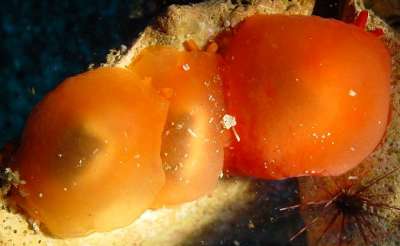
Dear Bill,
This notaspid is very common in Dakar. At the beginning, I was used to finding it at most of deep sites, at a depth of about 30-40m. All animals I saw were small, no more than 40mm in size. But one night I dived at a depth of only 4m and I saw a lot of specimens like this, but all of them were at least 70mm in length. All giants ! I was really astonished.
Of course, I followed your and Lucas Cervera's advice and I touched all these animals: but no any shell was detected. So, in Senegal I believed they were all Berthellina edwardsii. But now, Lucas Cervera told me that there is another Berthellina species near Cape Verde Islands which can be distinguished from Berthellina edwardsii only according to its internal anatomy. So, I fear we will never know what these animals really are.
Photos: near Dakar, Senegal, Eastern Atlantic.
Upper Right: Site: Le Grand Thiouriba. Depth: 35m. 31 May, 2003. Size: about 30-35mm.
Lower Left: Site: Kunk Diabar. Depth: 31m. 28 May, 2003. Size: 35-40mm
Lower Right: Site: Terou baye Sogui. Depth: 4m. 2 June, 2003. Size: 75-80mm
Photos: Marina Poddubetskaia - Nembro website
Cheers,
Marina.
nembro@nembro.info
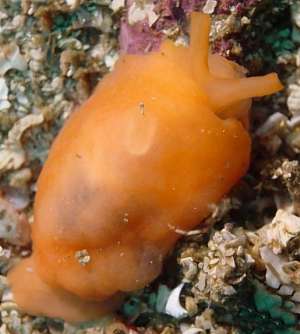
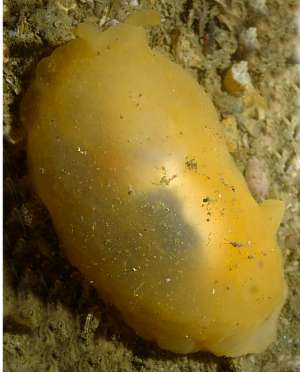
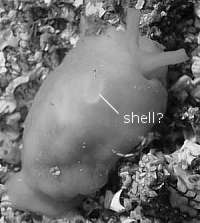
Thanks Marina,
Certainly if they felt soft and there was no sign of a large shell they are almost certainly a species of Berthellina. I can't be sure, but in your lower left photo, there is in the midline, the outline of a whitish oval object. It could be the bend in a duct, but it could also be the outline of its small shell. The size is right and the position of the shell in Berthellina is quite variable.
I'm afraid identifying these orange-yellow species of Berthellina is not possible from external features alone. If the anatomical differences being proposed at present prove constant, then it seems a scalpel will be the only way to confirm their identity. I'll file this on the Berthellina edwardsii Page, but not with total conviction.
Best wishes,
Bill Rudman
Berthellina from French Atlantic
October 11, 2002
From: Erwin Köhler
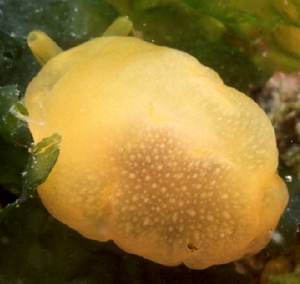
Dear Bill,
here is a photo from Bassin d'Arcachon, Atlantic coast of France by Michel Barrabés Email: m.barrabes@libertysurf.fr
He labelled it Berthellina engeli, but following the recent discussion on Berthellina this one should be B. edwardsii or an undescribed one? It also looks very much like Berthella aurantiaca (Risso, 1813) from the Mediterranean Sea (IDed by several scientists)
It's size is 1,5 - 2 cm, depth was 8 m,
31 Oct. 1998 during a night dive at "Balguerie"
Erwin
erwin@medslugs.de
Erwin Köhler, 2002 (Oct 11) Berthellina from French Atlantic. [Message in] Sea Slug Forum. Australian Museum, Sydney. Available from http://www.seaslugforum.net/find/8086Dear Erwin,
As Lucas Cervera has said in the previous discussion it is probably impossible to identify this group of species in the Mediterranean and nearby Atlantic, solely from photographs. The size of the internal shell can be used to separate Berthella and Berthellina, but to identify animals to the species level probably requires a look at the internal anatomy. Because this has only recently been realised it means that most earlier identifications of the orange-yellow Berthella & Berthellina group in the Mediterranean and nearby Atlantic are suspect. Because of this, we can't use earlier records to determine the geographical range of each species because we can't rely on their identifications - no matter how many scientists.
I have asked Lucas Cervera for his opinion. See his separate comments.
Best wishes,
Bill Rudman
Re: Berthella or Berthellina
October 11, 2002
From: Lucas Cervera
Dear Bill,
Concerning the photo from Michel Barrabes, the first thing would be to decide if this animal is Berthellina or Berthella. I think it is is a juvenile of a yellowish form of Berthellina edwardsi, since I assume that the dark shadow on the back is the digestive gland and not a shell. The shell color in Berthella is white/whitish or amber, not brown, and it covers a big percentange of the whole visceral mass.
Nevertheless, if I'm wrong, it should be Berthella plumula, not B. aurantiaca. In my view, most of the records of mediterranean "B. aurantiaca" during the last 50 years probably belongs to Berthellina edwardsi, that is much more common. Unfortunately, "B. aurantiaca" records are included basically in faunistic or ecological papers, that did not present any anatomical information. For this reason, my view could be considerd "very putative", but all the Mediterranean specimens that I have examined, that were labeled as Berthella auratiaca", were Berthellina.
In respect to the "papillae", they are not papillae, but the mantle acid glands that are more or less bottle-shaped. They are not difficult to see in Berthellina edwardsi or Berthella plumula or B. stellata. When the specimens are well preserved, they are very easy to see also in other species of the same genera. I cannot tell any more. As usual, the last word should be given by the dissection of the animal, but this is impossible in this case, obviously.
All the best.
Lucas.
lucas.cervera@uca.es
Cervera, J.L., 2002 (Oct 11) Re: Berthella or Berthellina. [Message in] Sea Slug Forum. Australian Museum, Sydney. Available from http://www.seaslugforum.net/find/8145Thanks Lucas,
Bill Rudman
Re: Berthella aurantiaca or Berthellina edwardsii?
July 22, 2002
From: Jean-Pierre Bielecki
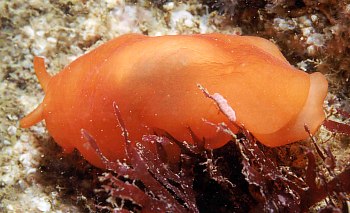
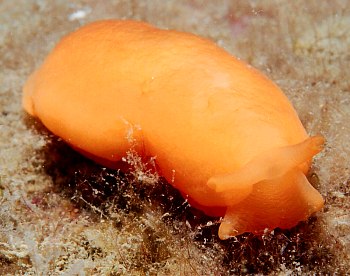
Hi Bill,
Here are more pictures of this Berthellina taken in its natural habitat. We found it during the “Sea slugs course” in Cerbère (on the border between France and Spain - Mediterranean coast). We organized with other “bio diving instructor” this “sea slugs course” with a scientist Gerard Breton, who is director of the Museum of natural history at Le Havre. This slug is the same animal that Marina, who took part to this training course as trainee, has already sent. She took the photo in a tank, after it was caught, and unfortunately it has lost its beautiful orange color. But I don't remember if its back was rigid or “squashy”, as we took every precaution to avoid hurting it so that the others could see it and we could let it go in good condition. I doubt it is so easy to feel the difference. Nevertheless it is the same species we found steadily during night dive or under the stones the day. Before this discussion, I thought it was in fact B. aurantiaca. Thank you Juan Lucas and Bill for correcting our small knowledge.
Best regards,
Jean-Pierre.
bielecki.jeanpierre@free.fr
Bielecki J-P., 2002 (Jul 22) Re: Berthella aurantiaca or Berthellina edwardsii?. [Message in] Sea Slug Forum. Australian Museum, Sydney. Available from http://www.seaslugforum.net/find/7602Dear Jean-Pierre,
We all learn from these discussions. I have seen Berthellina citrina become paler in colour, but I did not realise that animals could possibly lose all their colouration as shown in Marina's photos. I appreciate your concern about hurting these animals but if your finger is bare [no glove] it is usually quite east to feel the shell of a Berthella by a fairly gentle rubbing of the skin. I good way to get an idea of what to do would be to feel the shell of a Sea Hare by feeling the shell just beneath the mantle surface by rubbing the skin between the parapodia.
Best wishes,
Bill Rudman
Re: Berthella aurantiaca? from French Mediterranean
July 19, 2002
From: J. L. Cervera
Dear Marina and Bill,
It is impossible for me to be 100% sure of the specific identification of this pleurobranchid. Berthella aurantiaca and Berthellina edwardsii can be distinguished clearly by the shape of their radular teeth and their jaw elements. But externally is difficult. In my experience, the shell of Berthella can be detected through the mantle surface. You can't do this with the small shell in Berthellina edwardsii. The shell in B. aurantica covers almost all the visceral mass, while in Berthellina only covers a very small part of this.
I consider that Berthella aurantiaca is not a common species in Mediterranean, and many of the records in that area attributed to B. aurantiaca belongs to B. edwardsii in fact, but I cannot prove this. It's only my impression. With this in mind, I think that the Marina's animal is quite probably Berthellina edwardsii.
I hope this can help you.
Regards.
Lucas.
lucas.cervera@uca.es
Cervera, J.L., 2002 (Jul 19) Re: Berthella aurantiaca? from French Mediterranean. [Message in] Sea Slug Forum. Australian Museum, Sydney. Available from http://www.seaslugforum.net/find/7596Thanks Lucas,
Your comments are exactly the reason I hesitated about the identity of this animal. I gues we can never be sure, but I think I'll put it on the Berthellina edwardsii page.
Marina, next time you find any orange, yellow or pale whitish animal like this it might be an idea to gently press its back and see if you can feel a hard layer just under the skin. Its certainly quite easy to detect the difference between a 'squashy' back of Berthellina and the more rigid back of a Berthella.
Best wishes,
Bill Rudman
Berthella aurantiaca? from French Mediterranean
July 18, 2002
From: Marina Poddubetskaia
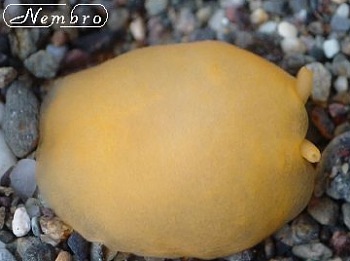
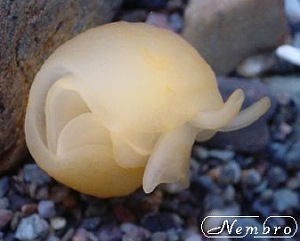
Dear Bill,
Could you confirm, please, the ID of this Berthella. Is it Berthella aurantiaca (Risso, 1813)?
Date: July 05, 2002
Location: Cerbere, France [Mediterranean Coast]
Site: La Ramere
Size: 25-30mm
Best wishes,
Marina.
nembro@nembro.info
Poddubetskaia, M., 2002 (Jul 18) Berthella aurantiaca? from French Mediterranean. [Message in] Sea Slug Forum. Australian Museum, Sydney. Available from http://www.seaslugforum.net/find/7478Dear Marina,
I am not quite sure if it is possible to distinguish a species of Berthella from a species of Berthellina from photos. This could be Berthella aurantiaca but it could be a colour form of Berthellina edwardsi. Perhaps Lucas Cervera can give us some advice
Best wishes,
Bill Rudman
Re: Berthellina from Canary Ids
April 15, 2000
From: Erwin Koehler
Dear Bill and Lucas,
Your comments and identifications are a great help for me, thanks to you and all other participants of the Sea Slug Forum. Tomorrow will I leave for 3 weeks to Spain and hopefully return with a lot of questions...
Erwin
Medslugs.Koehler@t-online.de
Koehler, E., 2000 (Apr 15) Re: Berthellina from Canary Ids. [Message in] Sea Slug Forum. Australian Museum, Sydney. Available from http://www.seaslugforum.net/find/2273Re: Berthellina from Canary Ids
April 14, 2000
From: Lucas Cervera
Dear Bill:
Concerning the identification of the species of Notaspidea from Canary Islands:
Regarding the Berthellina, as you know Terry Gosliner, Jose Carlos Garcia
Gomez and I are carrying out the world revision of this genus. The work is not finished still, but according our studies the best name for animals from Europe, Madeira, Azores and Canary Islands would be Berthellina edwardsii (Vayssiere, 1896). To know what the true identity of the so-called Berthellina engeli Gardiner, 1936 is impossible because the data on its internal anatomy does not permit us to compare it with the descriptions of other material. It could be B. edwardsii, but we cannot disregard the slight possibility that it is B. quadridens from the Caribbean. Both species have a similar shell, and this is the only material that remains from the original specimens of B. engeli.
I hope all this can help to Erwin Koehler.
All the best.
Lucas.
lucas.cervera@uca.es
Cervera, L. , 2000 (Apr 14) Re: Berthellina from Canary Ids. [Message in] Sea Slug Forum. Australian Museum, Sydney. Available from http://www.seaslugforum.net/find/2269Thanks again Lucas,
Bill Rudman.
Berthellina from Canary Ids
April 8, 2000
From: Erwin Koehler

Hi Bill,
this photo is from Gran Canaria Island, Spain, taken by Basilio Guerles,
email: kukyline@hotmail.com
Size about 5 cm, depth 0,5 m.
I think it is a Berthellina, but which species?
Erwin
Medslugs.Koehler@t-online.de
Koehler, E., 2000 (Apr 8) Berthellina from Canary Ids. [Message in] Sea Slug Forum. Australian Museum, Sydney. Available from http://www.seaslugforum.net/find/2230Dear Erwin,
It is definitely a Berthellina. At the Menfi Workshop Terry Gosliner & Lucas Cervera told us about some research they were doing on these orange animals worldwide.
I think it is best if we ask them to let us know what the latest position is on what species this is likely to be.
Best wishes,
Bill Rudman.
